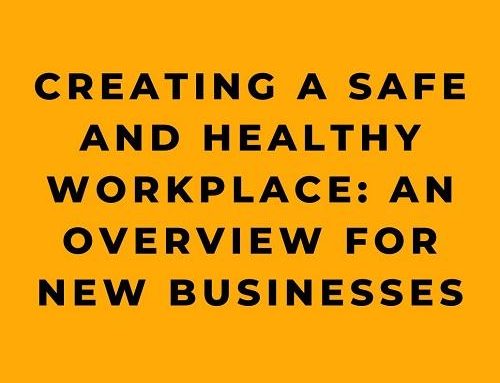Part 1, Part 2, Part 3, Part 4, Part 5, Part 6, Part 7, Part 8
As the calendar turned to the 2000s, the world found itself at the precipice of a new millennium, brimming with hope, anticipation, and uncertainty. In the realm of worker safety and health, this era was marked by significant events, regulatory changes, and a shifting landscape. Part 8 of this series of articles reflects on some of the most noteworthy events and people who shaped the U.S. Occupational Safety and Health Administration (OSHA) during this crucial period.
A New Leadership
On August 6, 2001, John Henshaw was confirmed by the Senate as the eleventh Assistant Secretary for OSHA. He brought over 25 years of experience as a safety and health professional for small and medium-sized businesses. Henshaw’s successor, Assistant Secretary Edwin G. Foulke, Jr., had served as the Chair of the OSH Review Commission in the early 1990s and began his career as an attorney practicing OSHA law in the late 1970s.
Influential External Factors
The new millennium saw several external factors that significantly impacted OSHA’s activities. Among them were the Needlestick Safety and Prevention Act, Congress’ use of the Congressional Review Act to reject the ergonomics rule, a series of articles and a documentary by The New York Times and FRONTLINE about McWane, Inc., and a petition by unions for an emergency temporary standard on diacetyl.
Major Incidents and Responses
Early in the new Administration’s term, the agency was faced with responding to major incidents, including the 9/11 terrorist attacks at the World Trade Center and the anthrax attacks at U.S. Postal Service facilities. Later, the 2005 explosions at the BP Texas City Refinery and the 2008 dust explosion at an Imperial Sugar Refinery would draw the agency into a national debate and criticism over Process Safety Management (PSM) and combustible dust issues.
OSHA played a critical role in the aftermath of other major incidents such as Hurricane Katrina and the bridge collapse in Minnesota. As a result, the development, updating, and implementation of improved Emergency Response capabilities became a top priority.
The Needlestick Safety and Prevention Act (2000)
On November 6, 2000, President Clinton signed the Needlestick Safety and Prevention Act, which mandated OSHA to revise its Bloodborne Pathogens (BBP) standard to include specific additional definitions and requirements. This act was the culmination of various important events, including a report from the Centers for Disease Control and Prevention (CDC) estimating that more than 380,000 percutaneous injuries from contaminated sharps occurred annually among healthcare workers in hospital settings across the nation.
Following the passage of the Needlestick Safety and Prevention Act, OSHA published a revision to the Bloodborne Pathogens standard in the Federal Register on January 18, 2001. The revisions, which went into effect on April 18, 2001, included new requirements for employers such as additions to the exposure control plan and maintaining a sharps injury log. The revisions also specified the engineering controls in greater detail, including the use of safer medical devices to reduce or eliminate employee exposures.
Congress Repeals the Ergonomics Rule (2001)
In March 2001, Congress repealed OSHA’s rule on ergonomics, which had been published a few months earlier by the Clinton administration. The rule, scheduled to take effect in October 2001, would have required employers to establish programs to reduce injuries caused by repetitive motion and other stressors to the musculoskeletal system. This marked the first time the Congressional Review Act was used to repeal a regulation.
Opponents of the rule argued that it was overly complex and would impose a significant burden on businesses. They believed that the cost of compliance far exceeded the potential savings in healthcare expenses, and that many employers had already implemented ergonomics programs for their employees.
In response to the repeal of the ergonomics rule, the Department of Labor conducted forums around the country and met with various stakeholders. Written comments and oral testimonies were collected from individuals representing labor, business, and the medical community. These efforts culminated in the April 2002 announcement of OSHA’s comprehensive four-pronged approach to reducing ergonomic injuries.
The World Trade Center Attack, 2001: Following the terrorist attacks on September 11, 2001, OSHA assumed a lead role in protecting the safety and health of responders at the World Trade Center site. This unprecedented disaster created a “worksite” unlike any other in the nation’s history, with rescue responders initially searching for survivors and later recovering the deceased amid an array of hazards. More than eight months of demolition and cleanup followed.
In a collaborative effort, OSHA, the City of New York, labor unions, contractors, and other government agencies worked together to ensure that no other injuries or fatalities occurred during the dangerous recovery operations. As part of the safety effort, OSHA provided compliance assistance, collected and analyzed over 24,000 air samples, and distributed more than 131,000 respirators. Additionally, the agency distributed 11,000 hard hats, 13,000 pairs of safety glasses, and over 21,000 pairs of protective gloves to employees on site. In total, OSHA ensured the elimination of more than 9,000 hazards, and there was not a single responder fatality during the 10-month cleanup operation.
Anthrax Incidents Involving U.S. Postal Service, 2001: In October 2001, two postal workers died after the Brentwood Mail Processing and Distribution Center in Washington, D.C., was contaminated with highly respirable Bacillus Anthracis spores. The spores were inhaled during the processing of contaminated letters that passed through mail-sorting machines. In response to the anthrax threat, OSHA spent hundreds of hours working with the Office of Homeland Security, USPS, EPA, and other government agencies.
The agency also assisted in the cleanup of a second contaminated postal facility in Connecticut, issued a risk assessment matrix, and placed information on its website to help employers assess the anthrax risk to their employees.
Prior to 2001, OSHA had not been recognized as a key participant in emergency response operations. However, the World Trade Center collapse and U.S. Postal Service anthrax emergency responses led the agency to take on a more prominent role in ensuring the safety and health of emergency response workers at disaster sites. These responses marked the beginning of the inclusion of employee safety and health policies in local and national emergency management plans and operations. Employee safety and health is now recognized as a critical part of disaster operations across the country.
McWane, Inc., 2002: In January 2003, The New York Times and FRONTLINE reported on McWane, Inc., a manufacturer of pipes and related components, in a series of newspaper articles and in the documentary “A Dangerous Business.” The investigation scrutinized unsafe working conditions, serious employee injuries, and OSHA’s inspection history at Tyler Pipe Company in Tyler, Texas – a subsidiary of McWane. This exposé highlighted the need for mechanisms within OSHA to identify corporate connections between business entities operating in multiple locations, including State Plan States.
Back in March 2003, John Henshaw, the Assistant Secretary, released a memo called “Enhanced Enforcement Program for Employers Who Are Indifferent to Their Obligations Under the OSH Act.” This memo aimed to crack down on businesses with a history of OSHA violations, and after four years, it became an official directive in 2008.
Now let me tell you about the BP Texas City disaster in 2005. On March 23, around 1:20 p.m., the BP refinery witnessed one of the worst industrial catastrophes in recent US history. A tower was overfilled, causing a flammable liquid to shoot up like a geyser. The explosion and fire that followed killed 15 people and injured 180. It was a tragedy that shook the community and cost more than $1.5 billion.
The Texas City refinery, owned by BP Products North America, was no small operation – it had a capacity of 460,000 barrels per day and could produce up to 11 million gallons of gasoline daily. After investigating the incident, OSHA slapped BP with 301 egregious willful violations and a $21 million penalty – the largest in OSHA history. It also led to the creation of OSHA’s National Emphasis Program in 2007, which called for inspections of all refineries under federal jurisdiction.
Hurricane Katrina: But that wasn’t the only disaster in 2005. Hurricane Katrina hit the Gulf Coast, and OSHA took charge in ensuring the safety of responders. Along with its state partners, OSHA worked with FEMA and other agencies to evaluate work practices, develop strategies, and provide proper safety information. OSHA and 27 state partners offered technical assistance at over 4,200 work locations, protecting around 6,800 employees from serious hazards.
Diacetyl: Now, let’s talk about diacetyl, a component in artificial butter flavoring. In 2006, the United Food and Commercial Workers International Union (UFCW) and the International Brotherhood of Teamsters (IBT) petitioned for an Emergency Temporary Standard (ETS) to protect employees exposed to diacetyl. They wanted a provisional exposure limit, respiratory protection, exposure monitoring, and medical surveillance. Although OSHA denied the ETS petition in 2007, they did launch a National Emphasis Program (NEP) for butter flavorings containing diacetyl in microwave popcorn manufacturing. To educate employers and employees about the risks, OSHA published online guidance on hazard control and communication in September 2007.
Minnesota Bridge Collapse, 2007: A Tragic Reminder of Infrastructure Fragility
On August 1, 2007, the I-35W Bridge in Minneapolis, Minnesota, unexpectedly collapsed, taking the lives of 13 people and injuring 98 others. Among the victims was a construction worker, a stark reminder of the inherent dangers of the profession. Spanning 1,907 feet across eight lanes, this vital link over the Mississippi River connected the northeast edge of downtown Minneapolis with the rest of the city. As the most heavily used bridge in Minnesota, it saw approximately 140,000 vehicles cross its expanse daily.
The catastrophe prompted immediate action from State and Federal OSHA, who swiftly mobilized resources to ensure the safety of responders during the ensuing weeks and months of recovery. Personnel from OSHA’s national, regional, and area offices were present at the site around the clock, providing expertise in various fields, such as crane operation, road construction, chemicals, diving, and structural engineering.
Throughout the recovery process, daily situation reports were compiled and submitted through Region V and to the national office. Federal and state OSHA staff worked alongside municipal, state, and federal entities, including the NTSB, FEMA, FBI, and a Navy dive team. A partnership agreement between Minnesota OSHA, Mn/DOT, and Bollander & Sons, the general contractor in charge of bridge removal, further ensured responder safety during the removal phase.
Remarkably, the collapsed bridge was entirely removed from the site within just nine weeks. It is also worth noting that throughout the entire operation, emergency response workers logged over 60,000 work hours without any lost time or recordable injuries. More than 4,500 hazards were identified and eliminated, and over 600 responders received mandatory initial site safety orientation training from Minnesota OSHA. Moreover, over 960 site-specific activity plans were submitted and approved.
Imperial Sugar Refinery Explosion, 2008: A Deadly Lesson in Combustible Dust Hazards
In February 2008, a devastating explosion at the Imperial Sugar Refinery in Port Wentworth, Georgia, claimed the lives of 14 employees and hospitalized 39 others. This disaster led to the third-largest fine in OSHA’s history, amounting to $8.7 million, for safety violations identified at the company’s facilities in Port Wentworth, Georgia, and Gramercy, Louisiana.
OSHA’s inspections of both facilities revealed large accumulations of combustible sugar dust in workrooms, on electrical motors, and other equipment. The investigation also determined that company officials were well aware of these conditions but failed to take reasonable actions to mitigate the evident hazards. The citations included 108 instances of willful violations, 10 citations for other willful violations, and 100 citations for serious violations.
In response to the tragedy, OSHA’s enforcement, education, and outreach programs were intensified to protect employees from combustible dust hazards. The assistant secretary issued a memorandum to state plan administrators, urging them to join OSHA in focusing on combustible dust hazards. Additionally, a two-hour refresher training on the subject was provided to 700 compliance officers, and the agency refined and expanded the combustible dust National Emphasis Program that had been announced in October 2007.
In the spring of 2008, OSHA’s Assistant Secretary testified on Capitol Hill about combustible dust hazards. This testimony highlighted the need for continued vigilance in addressing these hazards to protect workers and prevent future tragedies, like the Imperial Sugar Refinery explosion. The Assistant Secretary’s appearance before Congress was an essential part of ensuring that worker safety remained a top priority for the nation.
Significant Programs and Initiatives
Recordkeeping Rule Revised, 2001: In January 2001, OSHA published revisions to its recordkeeping regulations, marking the first time since 1978 that the rule had been revised. These revisions aimed to simplify the system, clarify concepts, and make better use of technology to streamline the process of tracking workplace injuries and illnesses. Along with the revised rule, the agency produced a recordkeeping policies and procedures manual with answers to frequently asked questions. In addition, a detailed Injury and Illness Recordkeeping website was established in 2002, containing links to helpful resources. The revised rule took effect in January 2002, marking a significant step forward in the way workplace safety data was collected and analyzed.
Alliance Program Launched, 2002: The Alliance program, initiated in 2002, brought OSHA together with businesses, trade or professional organizations, unions, and educational institutions. This collaborative effort led to the development of compliance assistance tools and the sharing of best practices, all aimed at preventing workplace injuries, illnesses, and fatalities. For example, eTools (stand-alone, interactive, web-based training) were developed under Alliances.
The success of the Alliance program garnered attention beyond OSHA. For example, the Mine Safety and Health Administration (MSHA) launched its own version of an alliance program in January 2003. Other agencies, including the Environmental Protection Agency, the Food and Nutrition Service, and the U.S. Department of Transportation, as well as DOL’s Office of Disability Employment Policy, approached OSHA about incorporating aspects of the program to enhance their compliance assistance efforts. Staff of the Directorate of Cooperative and State Programs also shared information on OSHA’s compliance assistance and cooperative programs, including Alliances, with representatives from Mexico and Australia.
Some of the critical issues addressed through the Alliance program included ergonomics, amputations, process safety management, and electrical hazards in the construction industry, among many others. The Alliance program continues to develop new products and solutions to improve worker safety and health.
Four-pronged Approach to Ergonomics, 2002: On April 5, 2002, OSHA unveiled a comprehensive plan designed to reduce ergonomic injuries through a combination of industry-targeted guidelines, enforcement measures, workplace outreach, and advanced research. Outreach efforts included a special focus on protecting Hispanic and other immigrant employees who might be particularly vulnerable to workplace hazards.
Guidelines: The agency immediately began work on developing industry and task-specific guidelines to reduce and prevent ergonomic injuries, often called musculoskeletal disorders (MSDs), that occur in the workplace. OSHA also encouraged other businesses and industries to develop additional guidelines of their own, thereby fostering a culture of safety across a broad range of workplaces.
Enforcement: The agency placed special emphasis on industries with significant ergonomic problems that OSHA and DOL attorneys had successfully addressed in prior 5(a)(1) or General Duty clause cases, including the Beverly Enterprises and Pepperidge Farm cases. For the first time, OSHA had an enforcement plan designed from the start to target prosecutable ergonomic violations. Also for the first time, inspections were to be coordinated with a legal strategy developed by DOL attorneys based on prior successful ergonomics cases, designed to maximize successful prosecutions.
Compliance Assistance: The plan also called for compliance assistance tools to help workplaces reduce and prevent ergonomic injuries. OSHA would provide specialized training and information to employers and employees in industries with significant ergonomics-related issues. This would be achieved through targeted outreach efforts, including seminars, workshops, and the dissemination of educational materials. OSHA also planned to work with other government agencies, industry associations, and labor organizations to create and promote the adoption of best practices to reduce ergonomic injuries.
Research and Evaluation: The fourth component of OSHA’s ergonomics plan was focused on research and evaluation. The agency aimed to support and sponsor studies that would help identify the most effective interventions for reducing and preventing workplace MSDs. This research would also help OSHA refine its understanding of the causes of ergonomic injuries and improve the efficacy of its guidelines and enforcement strategies. Furthermore, OSHA planned to assess the success of its ergonomics efforts through ongoing program evaluation and the collection of relevant injury and illness data.
National Emphasis Program (NEP) on Amputations, 2006: In an effort to reduce the number of amputations in the workplace, OSHA implemented the National Emphasis Program (NEP) on Amputations in 2006. The NEP focused on industries with high rates of amputations, such as manufacturing, food processing, and woodworking. The program aimed to identify and reduce hazards associated with amputations by increasing enforcement efforts, providing outreach and education, and promoting the use of machine guarding and other safety measures.
The NEP led to an increased number of inspections and citations related to machine guarding, as well as a heightened awareness of the dangers associated with amputations. OSHA’s efforts in this area resulted in a reduction in the number of amputations, saving countless workers from severe injuries and long-term disabilities.
In conclusion, OSHA’s efforts in the early 21st century have contributed significantly to the improvement of worker safety and health across the United States. The agency’s initiatives, such as the revision of recordkeeping rules, the Alliance program, the comprehensive ergonomics plan, and the National Emphasis Program on Amputations, showcase OSHA’s commitment to reducing workplace injuries and fatalities. OSHA continues to develop and implement innovative strategies to address emerging workplace hazards and ensure that all workers have the right to a safe and healthy work environment.
Part 1, Part 2, Part 3, Part 4, Part 5, Part 6, Part 7, Part 8
Reference:
- U.S. Department of Labor. “Reflections on OSHA’s History.” Occupational Safety and Health Administration, January 2009, OSHA 3360.










